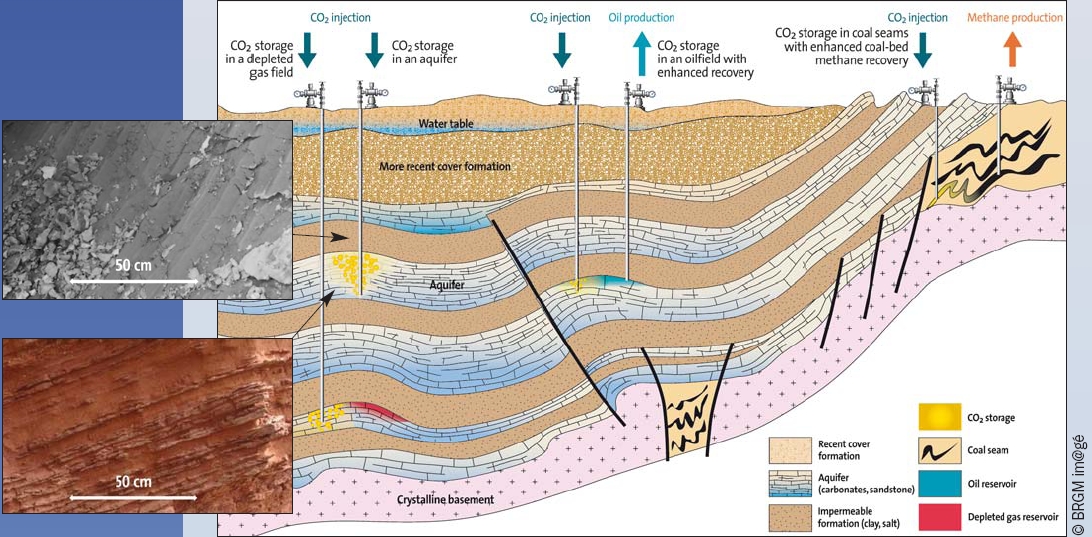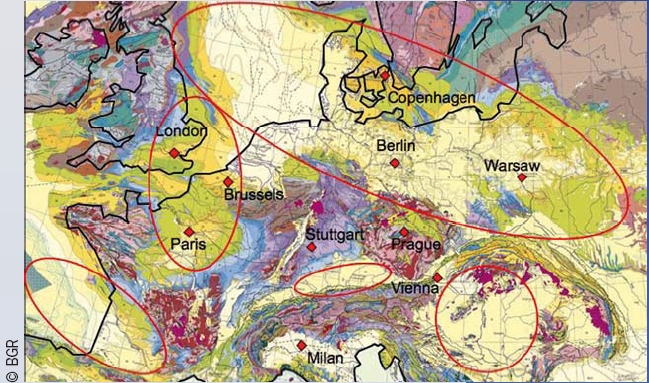
|
Where and how much CO2
can we store underground?
|
CO2 cannot be injected just anywhere underground, suitable host rock formations must first be identified. Potential reservoirs for CO2 geological storage exist throughout the world and offer sufficient capacity to make a significant contribution to mitigating human-induced climate change.
Three main storage options exist for CO2 (Fig. 1):
1. Depleted natural gas and oil fields – well known due to hydrocarbon exploration and exploitation, offer immediate opportunities for CO2 storage;
2. Saline aquifers – offer a larger storage potential, but are generally not as well known;
3. Unmineable coal seams – an option for the future, once the problem of how to inject large volumes of CO2 into low-permeability* coal has been solved.

|
Figure 1
CO2 is injected into deep geological layers of porous and permeable rocks (cf. sandstone in bottom inset), overlain by impermeable rocks (cf. claystone in top inset) that prevent the CO2 from escaping to the surface. The main storage options include:
1. Depleted oil/gas reservoirs with enhanced recovery where possible;
2. Aquifers bearing salty water unfit for human consumption;
3. Deep unmineable coal seams locally associated with enhanced methane recovery.
|
The reservoirs
Once injected underground into a suitable reservoir rock, the CO2 accumulates in the pores between grains and in fractures, thus displacing and replacing any existing fluid such as gas, water or oil. Suitable host rocks for CO2 geological storage should therefore have a high porosity* and permeability. Such rock formations, the result of the deposition of sediments in the geological past, are commonly located in so-called “sedimentary basins”. In places, these permeable formations alternate with impermeable rocks, which can act as an impervious seal. Sedimentary basins often host hydrocarbon reservoirs and natural CO2 fields, which proves their ability to retain fluids for long periods of time, having naturally trapped oil, gas and even pure CO2 for millions of years.
The subsurface is often depicted as an over-simplified, homogeneous, layer-cake structure in illustrations showing the possible storage options for CO2. In reality, however, it is composed of unevenly distributed and locally faulted rock formations, reservoirs and cap rocks forming complex, heterogeneous structures. In-depth knowledge of the site and geoscientific experience are required to assess the suitability of underground structures that are proposed for long-term CO2 storage.
Potential CO2 storage reservoirs must fulfil many criteria, the essential ones being:
• sufficient porosity, permeability and storage capacity;
• the presence of overlying impermeable rock – the so-called “cap rock” (e.g. clay, clay stone, marl, salt rock), which prevents the CO2 from migrating upwards;
• the presence of “trapping structures” – in other words features, such as a dome-shaped cap rock, that can control the extent of CO2 migration within the storage formation;
• location deeper than 800 m, where pressures and temperatures are high enough to enable the storage of CO2 in a compressed fluid phase and thus maximize the quantity stored;
• the absence of drinking water: CO2 will not be injected into waters fit for human consumption and activities.
Where to find storage sites in Europe
Sedimentary basins are widespread throughout Europe, for example offshore in the North Sea or onshore surrounding the Alpine mountain chains (Fig. 2). Many formations in the European basins fulfil the criteria for geological storage, and are currently being mapped and characterized by researchers. Other European areas are composed of ancient consolidated crust, such as much of Scandinavia, and thus do not host rocks suitable for CO2 storage.
One example of an area with potential for storage is the Southern Permian Basin, which extends from England to Poland (represented on Figure 2 by the largest ellipse). The sediments have been affected by rock-forming processes that left some of the pore space filled with saline water, oil or natural gas. The clay layers that exist between the porous sandstones have been compacted to low-permeability strata, which prevent fluid ascent. Much of the sandstone formations are located at depths between 1 and 4 km, where pressure is high enough to store CO2 as a dense phase. The salt content in the formation waters increases in this depth interval from about 100 g/l to 400 g/l, in other words, much saltier than seawater (35 g/l). Movements in the basin have caused plastic deformation of the rock salt, creating hundreds of dome-shaped structures that subsequently trapped natural gas. It is these traps that are being studied for eventual CO2 storage sites and pilot projects.

|
Figure 2
Geological Map of Europe showing the location of the main sedimentary basins (red ellipses) where suitable reservoirs for CO2 storage can be found (based on the Geological Map of Europe at 1:5,000,000 scale).
|
Storage capacity
Knowledge of CO2 storage capacity is needed by politicians, regulatory authorities and storage operators. Storage capacity estimates are usually highly approximate and based on the spatial extent of potentially suitable formations. Capacity can be assessed on different scales, from national scale for rough estimates, through to basin and reservoir scale for more precise calculations that take into account the heterogeneity and complexity of the real geological structure.
Volumetric Capacity: Published national storage capacities are generally based on calculations of the formations' pore volume. In theory, the storage capacity of a given formation can be calculated by multiplying its area by its thickness, its average porosity and the average density of CO2 at reservoir depth conditions. However, because the pore space is already occupied by water, only a small part can be used for storage, generally assumed to be about 1-3%. This storage capacity coefficient is then applied when assessing the volumetric capacity.
Realistic Capacity: More realistic capacity estimates can be made on single storage sites through detailed investigations. Formation thickness is not constant, and reservoir properties can vary over short distances. Knowledge of the size, shape and geological properties of structures allows us to reduce the uncertainties in the volume calculations. Based on this information, computer simulations can then be used to predict CO2 injection and movement within the reservoir in order to estimate a realistic storage capacity.
Viable Capacity: Capacity is not merely a question of rock physics. Socio-economic factors also influence whether or not a suitable site will be used. For example, moving CO2 from the source to the storage site will be governed by transportation costs. Capacity will also depend on the purity of the CO2, as the presence of other gases will reduce the reservoir volume available for CO2. Finally, political choices and public acceptance will have the last say as to whether or not the available reservoir capacity will actually be exploited.

|
In conclusion, we know that the capacity for CO2 storage in Europe is high, even if uncertainties exist related to reservoir complexity, heterogeneity and socioeconomic factors. The EU project GESTCO* estimated the CO2 storage capacity in hydrocarbon fields in and around the North Sea at 37 Gt, which would enable large installations in this region to inject CO2 for several decades. Updating and further mapping of storage capacities in Europe is a matter of ongoing research, in individual member states and through the EU Geocapacity* project for Europe at large.
|
Source: The European Network of Excellence on the Geological Storage of CO2
<< Previous page
---
Next page >>
TOP
|





